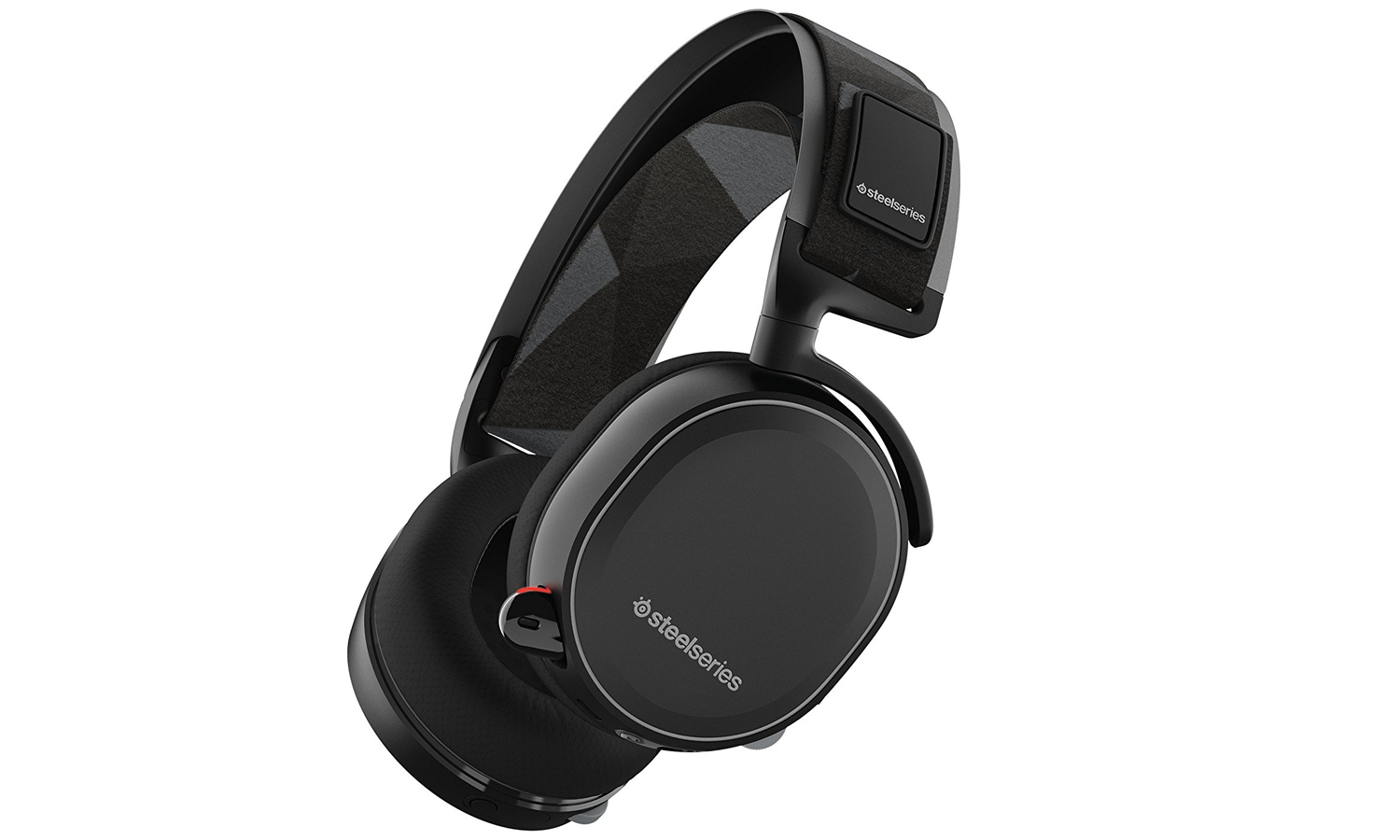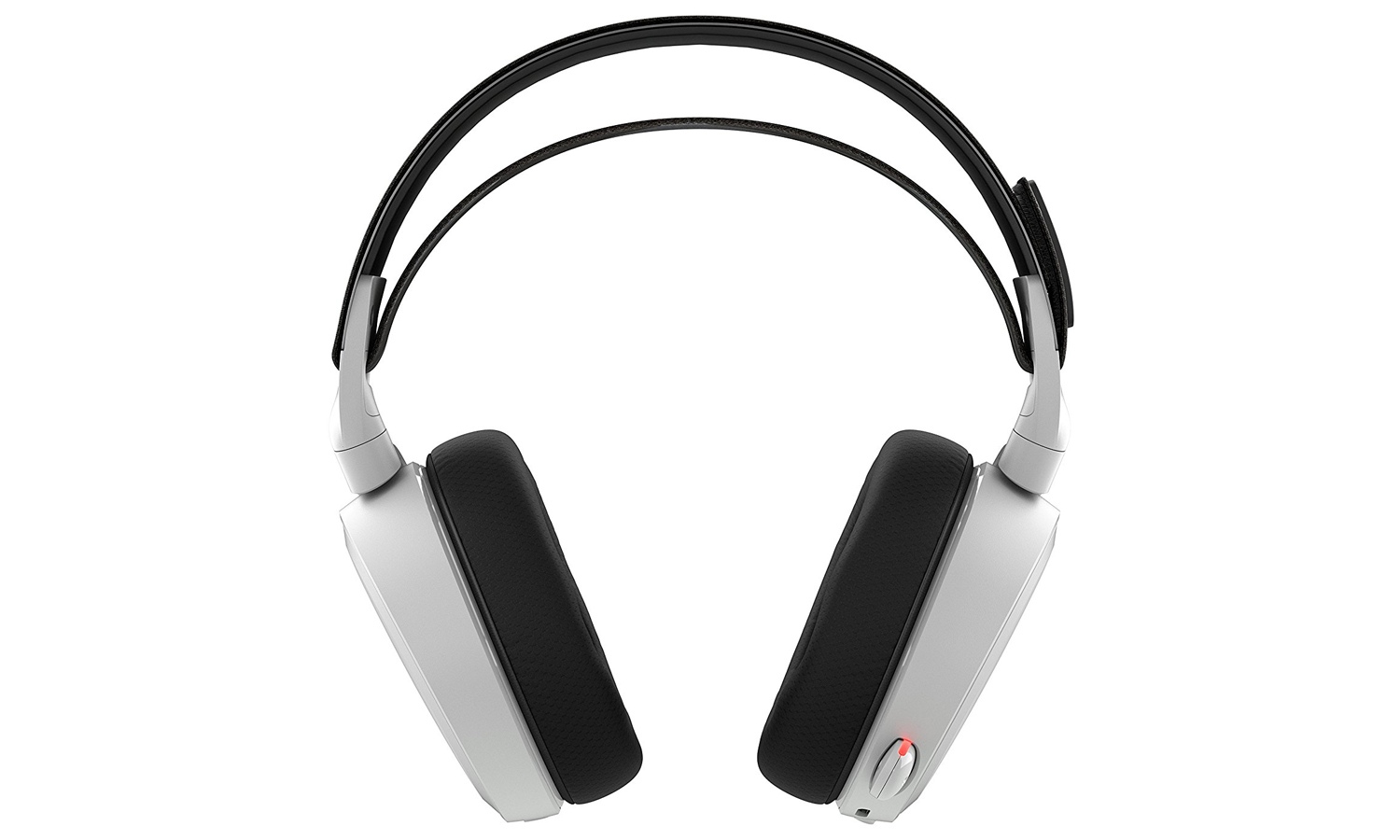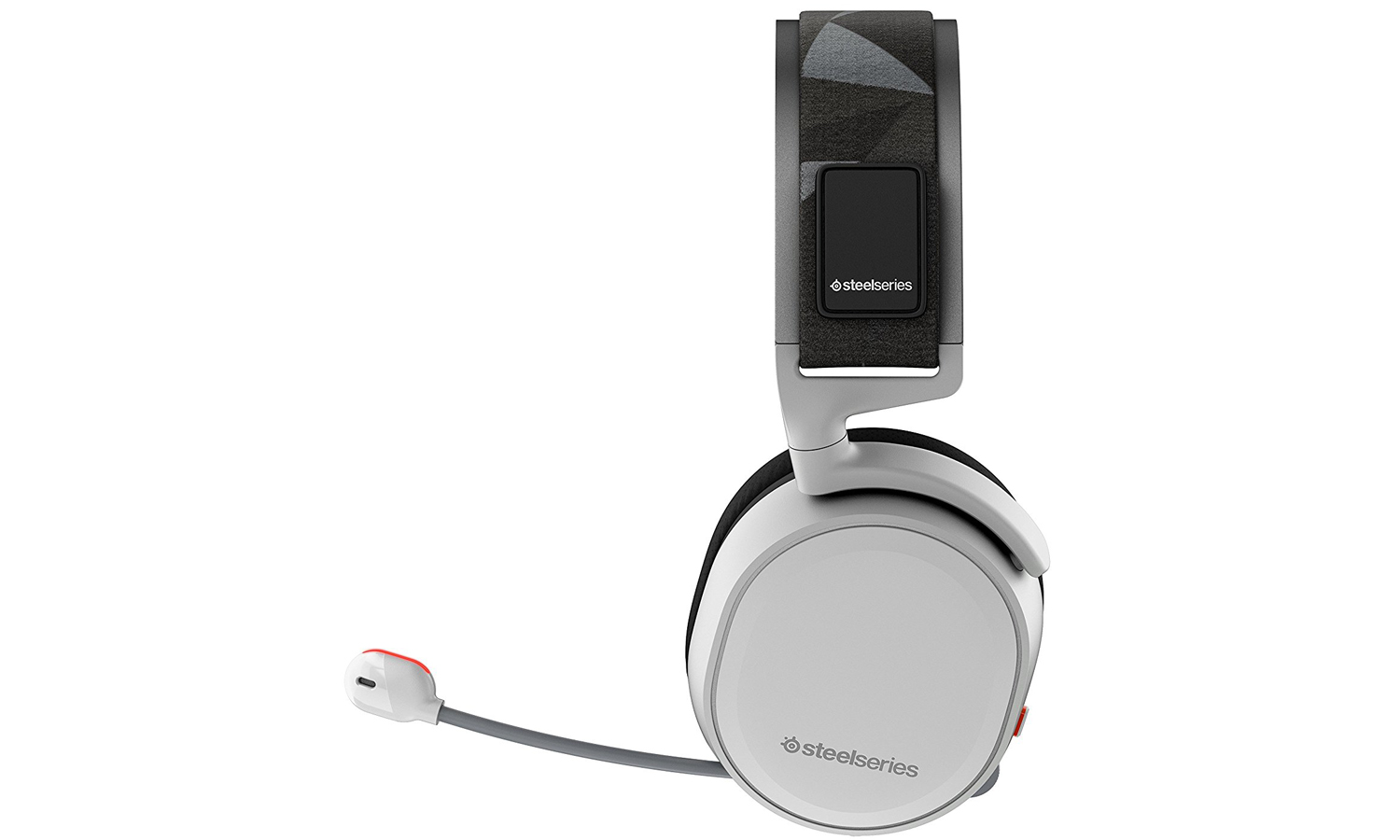Tom's Guide Verdict
The SteelSeries Arctis 7 sets the standard for what a wireless gaming headset should be: functional, versatile and practical.
Pros
- +
Great sound
- +
Comfortable fit
- +
Reasonable price
- +
Seamless wireless
Cons
- -
Fine-tuning music takes some work
- -
Roundabout phone and speaker functionality
Why you can trust Tom's Guide
UPDATE, 5/17: The SteelSeries Arctis 7 has been effectively replaced by the SteelSeries Arctis 7P/7X. The design and functionality is identical, but the 7P/7X uses a USB-C adapter to facilitate wireless connections with a greater range of devices. Consult our SteelSeries Arctis 7P/7X review for more details.
The SteelSeries Arctis has been on our list of the best gaming headsets ever since it first launched. The only headset with similar versatility is the SteelSeries Arctis 1 Wireless. However, the Arctis 1 Wireless doesn't have the same comfortable elastic headband or premium sound as the Arctis 7, making the Arctis 7 a better overall investment for the PC and the PS4.
If you're going to pay a premium for a wireless gaming headset, it should sound great, of course, but it should also be comfortable, work with as many devices as possible and look stylish. The SteelSeries Arctis 7 ($150) achieves all of these aims with flying colors, and at a reasonable price to boot.
While you'll have to rely on a few annoying work-arounds to make use of every feature, the Arctis 7 sets the standard for what the best gaming headsets should be: functional, versatile and practical. Read on in our full SteelSeries Arctis 7 review to learn what we thought.
Compatibility: PS4, Xbox One, Switch, mobile, PC| Drivers: 40mm | Frequency Response: 20 Hz - 20 kHz | Wireless: Yes
SteelSeries Arctis 7 price and availability
The SteelSeries Arctis 7 usually retails for $150. It's usually easy to find on both Amazon and Best Buy.
SteelSeries Arctis 7 design
As you can see in our review of the SteelSeries Arctis 5, the appearance of the Arctis 7 is nearly identical. The headset is sleek and sophisticated, with an elegant, streamlined appearance and an absolutely foolproof adjustable headband. Rather than having to monkey around with rigid extendable rods, you just adjust two Velcro straps, and the flexible headband will conform to your head's size and shape.
- The best gaming mouse
- Also consider the best gaming keyboards
Past that, the Arctis 7 comes in either black or white, and there's nothing in particular to draw the eye. You could easily wear the headset on the subway without getting a second glance, and while the Arctis 7 is a bit bigger than a standard set of audio headphones, it's still small enough that you can toss it in a backpack. You can even rotate the ear cups to make the device lie flat.
Get instant access to breaking news, the hottest reviews, great deals and helpful tips.

The right ear cup houses a power button and a chat volume slider. A regular volume slider resides on the left ear cup, along with a micro USB port for charging and a proprietary port that can connect to a 3.5mm audio jack for mobile listening. Although the Arctis 7 requires power for wireless and surround-sound functionality, you can listen to whatever you want with the audio jack, whether or not the device has power.
The headset's elastic band consistently provides much more reliable and comfortable results than trying to extend two extremely fickle notched arms.
SteelSeries Arctis 7 comfort
As discussed above, the elastic band makes finding the perfect fit with the Arctis 7 easy. I'm constantly surprised that of all the major headset manufacturers, only SteelSeries has embraced this approach, which consistently provides much more reliable and comfortable results than trying to extend two extremely fickle notched arms.

The ear cups created a tight seal around my ears, but I never felt that the cups pushed down too hard. My only issue was that they tended to bounce around while I walked, meaning that they could prove frustrating if you plan to wear them while out and about. Tightening the Velcro strap alleviated this problem, although getting the perfect balance between comfort and fit involved some trial and error.
I handed the Arctis 7 off to a co-worker, who generally found them very comfortable. He said the ear cups felt too snug at first but grew on him after about half an hour. He also cited the device's lightweight feel as a benefit — not surprising, considering that the peripheral weighs only 9.9 ounces.
SteelSeries Arctis 7 gaming performance
Like its wired counterpart, the Arctis 7 provides stellar gaming options — if you're willing to do some legwork. With both stereo and DTS 7.1 surround sound, as well as a plethora of equalization options, you can get wildly different configurations from the headset, whether you want to listen to music or have a Skype conversation. Luckily, setting up game profiles is pretty simple.
Surround sound in Overwatch made my foes' footsteps sound immediate and urgent, while using the Immersion setting for The Witcher 3 provided a clean balance among dialogue, swordplay and the pounding gale of a storm at sea.
Using the SteelSeries Engine 3 software, you can toy around with the surround-sound and equalization settings, then create profiles and link them to individual games and programs. I tested sound profiles with Overwatch, The Witcher 3: Wild Hunt, StarCraft II: Nova Covert Ops and Marvel Heroes to see how the headset tackled multiple genres.
On the Flat equalization option with Stereo audio, everything sounded good, from Captain America's battle cries to the death screams of Zerg as Terran armies mowed them down. A little bit of tweaking, however, made things sound great. Surround sound in Overwatch made my foes' footsteps and my teammates' cries for help sound immediate and urgent, while the Immersion setting in The Witcher 3 provided a clean balance among dialogue, swordplay and the pounding gale of a storm at sea.
You can also rig up the Arctis 7 with a PS4 or Xbox One by plugging the audio jack into a controller (the PS4 also works wirelessly with the USB dongle). Although you'll have to sacrifice the surround-sound options, the peripheral still provides good audio, and the mic is excellent for competitive multiplayer matches.
SteelSeries Arctis 7 music performance
For music, the Arctis 7 doesn't quite live up to its gaming performance. I listened to tracks from Flogging Molly, Old Crow Medicine Show and the Rolling Stones, as well as G.F. Handel's "Messiah," and I was pleased by the keen balance among vocals, treble instruments and bass instruments. Surround sound made choral pieces sound like I was sitting in a cathedral, while stereo sufficed for all my favorite rock and punk hits.
On the other hand, for each new track, I had to open up the Engine 3 software and toy around with it before I found the right balance of surround-sound and equalization options for each genre. Both the surround and stereo modes have Music presets, and they both sound pretty good, most of the time. On Flogging Molly's "Salty Dog," the default modes de-emphasized vocals too much, while those modes provided one of the best renditions of "Let It Bleed" by the Rolling Stones I'd ever heard.
That the music options are inconsistent on a gaming headset is unsurprising and somewhat forgivable. Music sounds good, and everyone but the most dedicated audiophiles could use the Arctis 7 as an everyday music headset. But if there's one category where this headset just misses peak performance, it's in how the device handles music.
SteelSeries Arctis 7 features
First and foremost, the Arctis 7 is a wireless headset. Simply plug in a wireless amplifier to a USB port on your computer, pair that amplifier with the headset, and you're good to go. The wireless is crystal clear, and worked from up to about 30 feet in my tests.

The Arctis 7 runs on the SteelSeries Engine 3 software, a clean, intuitive and well-designed program that keeps tabs on just about every modern SteelSeries peripheral. In addition to setting up sound profiles, you can also toy around with mic options; otherwise, the program doesn't offer too many bells and whistles for this particular peripheral. Unlike on the Arctis 5, there are no colored RGB lights on the ear cups. In my opinion, this is a negligible loss, as users can't see colored lights on their own headsets anyway.
One thing in particular that I liked was the program's Library sections, where it keeps tabs of all the profiles you've created for various games, and stores every peripheral's profile under the same heading. If you've made a mouse, keyboard and headset profile for The Witcher 3, for example, you'll see them all in the same box. This is a very convenient way to sync all of your peripherals, provided they all come from SteelSeries.
You can also leverage the device's wireless capabilities for a phone or speaker, although doing so is a little convoluted. By supplying your own audio cable, you can plug a phone into the amplifier, or the amplifier into a speaker. While this is not as convenient as having Bluetooth built in, it does mean that you can stream wireless audio to and from more than just a computer and a headset, which is more than I expected from a $150 wireless peripheral.

The headset also comes with a retractable, flexible mic in the left ear cup. Like the mic on the Arctis 5, it's a high-end device that captures sound in clear and subtle patterns, although it still goes a bit heavy on the "p" and "s" sounds. I wouldn't record a podcast with it, but it's more than adequate for competitive gaming or streaming on Twitch.
Other SteelSeries Arctis models
There are other varieties of Arctis headset, including the Arctis 3 and the Arctis 5. While the headsets share similar designs and features, the Arctis 3 and the Arctis 5 are not quite as high-end as the Arctis 7. The Arctis 3 ($80) connects only via 3.5mm jack, meaning users can't tweak equalization options. The Arctis 5 ($100) has a USB connection. Neither the 3 nor the 5 has wireless features, which is the primary reason that the Arctis 7 costs more.
More recently, SteelSeries debuted the SteelSeries Arctis 9: a $200 wireless headset with Bluetooth features. If you wished the SteelSeries Arctis 7 had wireless compatibility with mobile devices, this is probably the gadget for you. However, the sound quality is about the same as Arctis 7, so you're essentially paying an extra $50 for Bluetooth functionality. Whether that's worthwhile depends on how much you use your phone for music and games.
SteelSeries Arctis 7 verdict
Considering that wireless headsets can run hundreds of dollars, and PC-centric ones often leave out important features like 3.5mm jacks, it's refreshing that the Arctis 7 offers the complete package for only $50 more than its wired counterpart. While some of the features require a little legwork from the user, nothing is difficult, and everything works exactly as it's supposed to. Add in great sound — for games more so than music — and the Arctis 7 is a difficult proposition to resist. We haven't arrived at the perfect gaming headset just yet, but our SteelSeries Arctis 7 review demonstrates that this is about as close as any company has come.

Marshall Honorof was a senior editor for Tom's Guide, overseeing the site's coverage of gaming hardware and software. He comes from a science writing background, having studied paleomammalogy, biological anthropology, and the history of science and technology. After hours, you can find him practicing taekwondo or doing deep dives on classic sci-fi.
-
David_582 Hi!Reply
Can you please explain the below in more detail? My understanding is it is impossible to use wireless with a phone.
'You can also leverage the device's wireless capabilities for a phone or speaker, although doing so is a little convoluted. By supplying your own audio cable, you can plug a phone into the amplifier'
What is the cord you are buying to do the above!?
Cheers -
llSeekarioll I have the artics 7 and im very pleased.Reply
To answer you question @david_582 , you cant connect it wireless to a phone, since in order to connect it wireless you need to connect , the (included) usb dongle must be connected to the device reproducing the sound (ps4 or pc) also comes with another cable 3.5mm jack that connects to audio devices like a phone or an ipod. -
goldcd My Arctis 7 arrived today, and so far it's faultless.Reply
With PC (or apparently PS) you can plug in the dongle and get wireless sound.
Also comes with a phono jack you can plug into a phone (or anything else) that gives you wired sound and mic.
Bluetooth would have been a nice bonus, but not one I'd be prepared to pay for as I'm only really going to use this with my PC.
Standout features for me are the build and fit - elastic strap is adjustment makes me question why nobody else thought of this.
Something that is missed in the review is that it registers as two separate output devices "game" and "chat"
Means I can bind Mumble (or your VOIP chat of choice) to the "chat" output and everything else to "game".
On your left ear you have your volume control as normal, but on your right you have a mixer allowing you to fade between game volume and mumble. SO much easier to give that a prod if you can't hear people, without having to drop out of the game and mess with app sliders. -
Varza This review wasted me $200. The sound quality is atrocious. My old GameCom 780 (which is less than half the price) has much much better sound. The Arctis has no bass and despite that the sound is still washed out.Reply -
goldcd Reply19268783 said:I have the artics 7 and im very pleased.
19314096 said:This review wasted me $200. The sound quality is atrocious. My old GameCom 780 (which is less than half the price) has much much better sound. The Arctis has no bass and despite that the sound is still washed out.
They're definitely not bass-heavy, which was something I was looking for. Don't find the sound washed out though - unless I'm trying to listen to music with the DTS-X option turned on, which does make it sound pretty horrible. If that's your problem, you can fix it using the app. Leave it on for the default, but setup a profile with it off, then link it auto-switch for your browser and anyother app you listen to music on.
-
Petestacy21 Awesome review.Reply
This might be one of the best headsets Ive ever had.
Not regretting using a little more money and buying this instead of razer man o war which i thought of buying too.
GJ Steelseries :)

